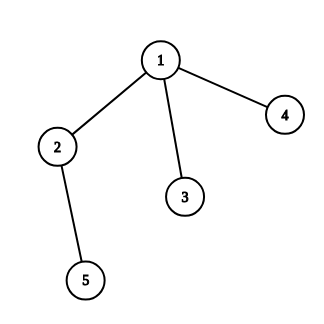Add on a Tree
题意翻译
给定一棵树,树上的边权初始为0,你可以在任意两个叶子之间的简单路径上的边上加上一个权值实数x。问:能否在有限次数的操作内,得到边权任意组合的树。
题目描述
Note that this is the first problem of the two similar problems. You can hack this problem only if you solve both problems.
You are given a tree with $ n $ nodes. In the beginning, $ 0 $ is written on all edges. In one operation, you can choose any $ 2 $ distinct leaves $ u $ , $ v $ and any real number $ x $ and add $ x $ to values written on all edges on the simple path between $ u $ and $ v $ .
For example, on the picture below you can see the result of applying two operations to the graph: adding $ 2 $ on the path from $ 7 $ to $ 6 $ , and then adding $ -0.5 $ on the path from $ 4 $ to $ 5 $ .
Is it true that for any configuration of real numbers written on edges, we can achieve it with a finite number of operations?
Leaf is a node of a tree of degree $ 1 $ . Simple path is a path that doesn't contain any node twice.
输入输出格式
输入格式
The first line contains a single integer $ n $ ( $ 2 \le n \le 10^5 $ ) — the number of nodes.
Each of the next $ n-1 $ lines contains two integers $ u $ and $ v $ ( $ 1 \le u, v \le n $ , $ u \neq v $ ), meaning that there is an edge between nodes $ u $ and $ v $ . It is guaranteed that these edges form a tree.
输出格式
If there is a configuration of real numbers written on edges of the tree that we can't achieve by performing the operations, output "NO".
Otherwise, output "YES".
You can print each letter in any case (upper or lower).
输入输出样例
输入样例 #1
2
1 2
输出样例 #1
YES输入样例 #2
3
1 2
2 3
输出样例 #2
NO输入样例 #3
5
1 2
1 3
1 4
2 5
输出样例 #3
NO输入样例 #4
6
1 2
1 3
1 4
2 5
2 6
输出样例 #4
YES说明
In the first example, we can add any real $ x $ to the value written on the only edge $ (1, 2) $ .
In the second example, one of configurations that we can't reach is $ 0 $ written on $ (1, 2) $ and $ 1 $ written on $ (2, 3) $ .
Below you can see graphs from examples $ 3 $ , $ 4 $ :
 